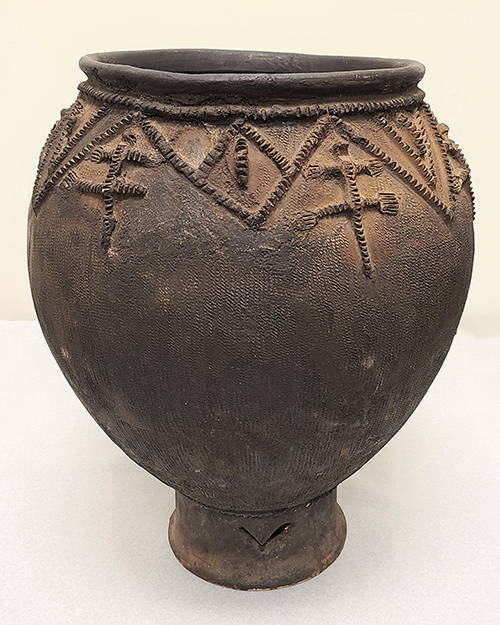Bamana Water Container

The Bamana people are the largest ethnic group in the country of Mali with a population of about 2 million people. They are part of the Mande culture, and they have lived in the savannah in the west-central part of the country for hundreds of years.
Bamana society’s strict hierarchy dictates that only the wives and daughters of blacksmiths can be potters. They are known as numumusow which means “blacksmith women.” They are part of a larger artisan class called nyamakalaw which also includes blacksmiths, woodcarvers, weavers, and leatherworkers. Restrictive marriage traditions keep the artisan class separate. Farmers and traders are not allowed to marry artisans.
Bamana potters are believed to have special abilities to control natural and supernatural energy (nyama), which allows them to create pottery from raw clay. Because of this ability, potters often take on additional roles in the community as healers. They also play important roles in events and ceremonies by preparing sacrificial meals and dressing hair for special occasions.
Pottery making is a very labor-intensive process, from digging the clay, to building the pots, to wood firing in open air. Potters start containers like this one by forming a slab of clay over a mold, often an old pot. The rough texture is created by a tool covered in netted fabric. After making the base, coils are added to complete the pot’s walls, lip, and base. After a pot is fired, the black color is created by submerging it in a bath of tree bark or acacia seed pods. Young girls often assist the women of their household to learn basic pottery skills. They will not make their own pottery, however, until they are married and have joined their husband’s family.
This type of Bamana water container is called jidaga. They are placed in an easily accessible spot in the courtyard of a family compound, often under a tree. There, they are used to serve visitors cool water to drink. These medium-sized containers (this one is 21” tall) are the most decorated of Bamana pots because they are prominently displayed.
This pot is decorated with geometric designs and lizards modeled in low relief. Lizards were once a common motif on Bamana water containers. The lizard is a gne, or family totem, which possesses protective powers. This pot dates to the early to mid-20th century. Lizard decorations, and raised designs in general, are no longer popular on Bamana pottery. Modern water containers are often painted with red slip designs before firing.
Other objects from Mali that have been featured for Artifact of the Month include a Dogon ladder, a Dogon mask, a Bamana door lock, and a Tuareg Tent Post.
